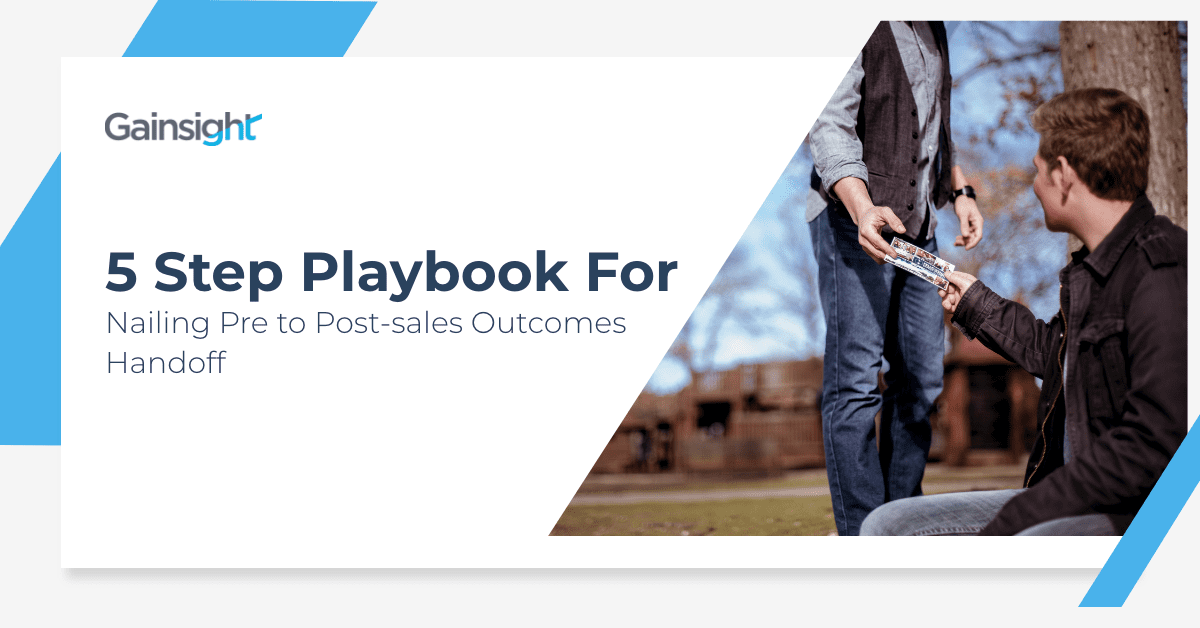This post was co-authored by Ashvin Vaidyanathan and Josh Weber.
Tell me if you’ve heard this one before:
- Customer spends months explaining their goals and desired outcomes to a sales rep
- Sales rep closes the deal
- Ring the gong!
- CSM and/or Services team kickoff the onboarding call with “so tell me what outcomes you’re hoping to achieve with our product.”
Handoffs
If you go through the dictionary of buzzwords in Customer Success, right between “adoption” and “proactive,” you’ll find “handoff.” I can’t count the number of times CS leaders have told me about their desire to improve handoffs from pre to post-sales.
Of course, all of those terms are anachronistic:
- There is no pre-sales versus post-sales – it’s all a continuous cycle.
- Handoffs don’t work – the collaboration needs to be much tighter.
But the core idea still applies. Customer Success isn’t just a department – it’s a business process end-to-end, and it starts with the expectations set with Sales and Marketing at the beginning of the customer journey.
So far, every leader who works with cross-functional teams is vigorously nodding their heads and/or saying “duh,” or “YES…please, please tell me how to fix it!”
The question is, how many of you have operationalized this vision end-to-end? So far, I’ve met about a dozen companies that have done it—and I think this is by far the hottest trend in enterprise Customer Success and something we should all be striving towards.
The good news is a clear playbook is emerging with these 5 components.
1. Define a taxonomy of outcomes
Perhaps the hardest tactic is the first one. You have to agree, as a company, on what your product or solution does. I don’t mean what features your product has. I mean, what real value it drives.
Defining value turns out to be non-trivial. It lies in the answers to such questions, including: What is your definition of an outcome? What are the core categories of outcomes? How do they nest in a hierarchy? What’s at the top level? What words should you use? I like to think of the result here as an ala carte menu of outcomes from which customers make selections.
Establishing this menu for your organization requires involvement from Marketing, Sales, Product Management, Services, and Customer Success to make it work genuinely.
2. Create a simple way for sales to capture the client’s desired outcomes
Next, you need to define a way for sales to quickly capture and translate clients’ goals in an individual sales cycle in such a way that will allow them to be passed and operationalized in a single thread throughout the customer lifecycle.
Tactically, some companies use customized CRM forms for reps to enter this. Others use purpose-built pre-sales value tools like EcoSystems or Decision Link.
The critical question to figure out to make this work is, “how do we get reps to do this?”
I’ve found the companies that are the most successful at this make sure to have the process of helping CSMs in terms of capturing outcomes ALSO help sales by making the sales pitch better. Perhaps most importantly, they make the “What’s in it for me,” clear and present for sales teams (i.e., less friction in expansion motion, reduced time to expansion events, higher ACV at expansion, etc.).
Many companies show clients the process of capturing outcomes to help sell the “why” of working with the company, and what they can expect to achieve.
3. Operationalize a Success Plan to map to the pre-sales definition of outcomes automatically
As the kids say:
- Tired: CSM chasing down the sales rep/onboarding team to figure out why the client bought
- Wired: Automated creation of a Success Plan based upon the client’s goals
Automated Success Plans are pretty straightforward with Gainsight. Many of our clients have now “wired” (forgive my dad jokes – they go on for days) Salesforce fields to conditionally create tailored Gainsight Success Plans based upon the chosen outcomes.
Practically, this involves creating a set of template plans to map to each of the outcomes in the taxonomy.
4. Build the Success Plan into the product
If you want to take this process “to 11” (the kids definitely don’t get this reference, but check your Spinal Tap for more information), figure out how your product can reinforce the client’s chosen outcomes.
That might have been impossible a few years ago. But now, with Gainsight PX, clients are embedding personalized step-by-step guides into their products and helping users navigate the features tied to their specific goals helping them to move along their value journey, at scale.
5. Demonstrate value
What do you have now? You have a client who:
- Told you their goals ONCE
- Had an onboarding experience tied to the goals
- Saw the CSM working toward the goals without having to work backward
- Logged into the product and got guided to achieve the goals
It sounds like a perfect time to ask for more money! But seriously, it’s much easier to ask for more revenue if you have the results to substantiate the request. Now, as you walk into your Executive Business Review, you’ll have the perfect template:
- Why you bought
- What we implemented
- What outcomes we’ve achieved to date
- What you’ve used
Feels like step 6 should be profit!
Example: Splunk
As a practical example, Kevin Meeks, Vice President of Global CSM and Renewals at Splunk, presented at Pulse Everywhereon the smooth end-to-end process Splunk has built:
- Well-defined taxonomy around outcomes leveraging the Prescriptive Value Paths that they created
- A custom tool for sales that helps them capture client goals, assess their maturity, build an ROI model and hand things off to post-sales
- Success Plans in Gainsight CS mapped to those goals
- In-product guides using Gainsight PX tied to the client goals
- A robust end-to-end business process to demonstrate business value

